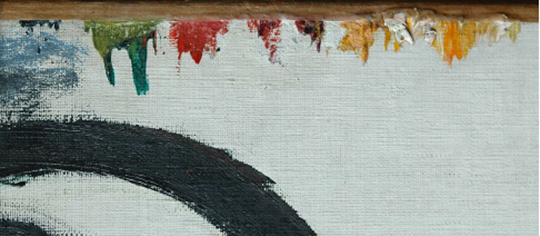
Femme (Woman), 1907, Pablo Picasso. Oil on canvas, 46 7/8 x 36 13/16 in. Fondation Beyeler, Riehen/Basel, Beyeler Collection. © 2015 Estate of Pablo Picasso / Artists Rights Society (ARS), New York
One rewarding part of doing an internship at the J. Paul Getty Museum has been the opportunity to study incredible paintings!
Pablo Picasso’s Femme, dated 1907, is an unfinished study related to Les Demoiselles d’Avignon. The painting was brought to the Getty by our visiting conservator Markus Gross from the Fondation Beyeler in Switzerland so that we could answer questions about Picasso’s materials and painting technique and analyze non-original materials from previous restorations for future treatment. The examination of Picasso’s Femme was a collaborative project between the Fondation Beyeler, the J. Paul Getty Museum, and the Getty Conservation Institute (GCI). The project was supported by the Getty Museum Paintings Council.
The scientific analysis of Femme involved the work of scientists across the Conservation Institute. A number of different analytical techniques were employed, but the painting was first subjected to different non-invasive imaging and spectroscopic techniques—in other words, those not requiring the removal of any samples. Specifically, we used X-radiography, infrared imaging, multispectral imaging, and X-ray fluorescence (XRF) spectroscopy.
X-radiography was carried out to learn more about the painting’s current condition. Similar to medical X-raying, this technique can reveal losses in the original paint layers through the differential appearance on X-ray of dense materials (such as lead white, often found in artists’ paints) and less dense materials (such as chalk, often used to fill losses during conservation treatments). X-radiography can also reveal pentimenti, or changes, that may have been painted over by the artist or during a previous restoration. While no compositional changes were identified in Picasso’s Femme, the X-radiograph provided useful information about areas of loss in the white background as well as the weave structure of the original canvas.
Infrared imaging was also carried out across the painting to learn more about any “hidden” features such as underdrawings or pentimenti, which may be invisible to the unaided eye. The infrared images revealed some hidden blue preparatory lines, painted in the initial painting stages and subsequently covered by the upper paint layers.
Multispectral imaging is another powerful imaging technique. Our camera system collects a series of images at 13 different wavelengths of light, from the visible (starting at about 400 nm) through the infrared (to about 1000 nm). The series of images created—each mapping out the reflectance and absorbance of the painting at all the different wavelengths—helps categorize the different materials present across an entire painting. For example, if a pigment used to retouch an area is visually similar, but chemically different, from the original paint, the multispectral images may show the areas that have been retouched. In Femme, the images also revealed distributions of the original pigments throughout the painting, such as the distribution of a dark blue pigment (identified as cobalt blue by XRF spectroscopy, as described below) in both upper and lower paint layers. This complementary approach using multispectral imaging with XRF allows us to characterize and map select materials throughout the entire painting in a non-invasive way.

Getty Conservation Institute associate scientist Catherine Patterson, Markus Gross (left) and me with the Bruker Artax portable XRF. Artwork: Fondation Beyeler, Riehen/Basel, Beyeler Collection. © 2015 Estate of Pablo Picasso / Artists Rights Society (ARS), New York
While imaging techniques can help characterize the number and types of pigments, to more specifically determine which pigments are present requires additional analysis. The technique that is perhaps most frequently used in the study of paintings is X-ray fluorescence (XRF) spectroscopy. XRF spectroscopy is a non-invasive elemental analytical technique that allows us to determine what chemical elements, such as copper, chromium, or lead, are present in a painting without sampling. The pigments can often be inferred from their elemental composition.
For example, if we detect mercury and sulfur in a red-colored area, we can be reasonably certain that the pigment vermilion (HgS) was used. For the analysis of Picasso’s Femme our results suggested a palette including lead white, cobalt blue, vermilion, a copper-arsenic green, bone black, iron oxides, and two cadmium sulfide yellows. This palette appears typical of Picasso’s practice based on the results of other contemporary Picasso paintings.

Detail of the palette at the top edge of the painting. Artwork: Fondation Beyeler, Riehen/Basel, Beyeler Collection. © 2015 Estate of Pablo Picasso / Artists Rights Society (ARS), New York
One interesting feature of this painting was the row of thickly applied paint splotches located along the top edge. While the palette had been previously damaged and retouched, areas of original paint remained intact throughout. It was initially thought that this row of paint comprised Picasso’s palette (the colors he used) in the main composition. However, one of the splotches was identified as chromium green, a pigment not identified anywhere in the main composition (which contained only a copper-arsenic green).
This scientific analysis therefore helped conservators understand whether the splotches of paint along the top edge of the painting represented the pigments Picasso used to paint Femme (i.e., his palette). The answer was no. While they matched the colors in the painting, they were not painted using the same kind of paint. So what were these splotches for?
A hint came not through scientific analysis, but a bit of old-fashioned detective work. Markus Gross found a historical photo of Femme dated to around 1908. This photo showed that Picasso completed the main composition of Femme before painting any of the splotches along the top edge. While the exact reason for the addition remains unknown, we speculate that Picasso may have been trying to match the colors in Femme or another painting he was working on in the studio. In the 1908 photo, the famous painting Les Demoiselles d’Avignon sits behind Femme. Is this the painting he was working on? We don’t yet know, as further analysis of Picasso’s works from this time is still required to ascertain whether he used chromium green in other oil paintings from this period.
While the scientific examination of Picasso’s Femme is ongoing, you can enjoy this fantastic painting in person while it hangs in our galleries, through March 15!

Femme with other femmes in the Getty Center’s West Pavilion. Artwork: Fondation Beyeler, Riehen/Basel, Beyeler Collection. © 2015 Estate of Pablo Picasso / Artists Rights Society (ARS), New York




Comments on this post are now closed.